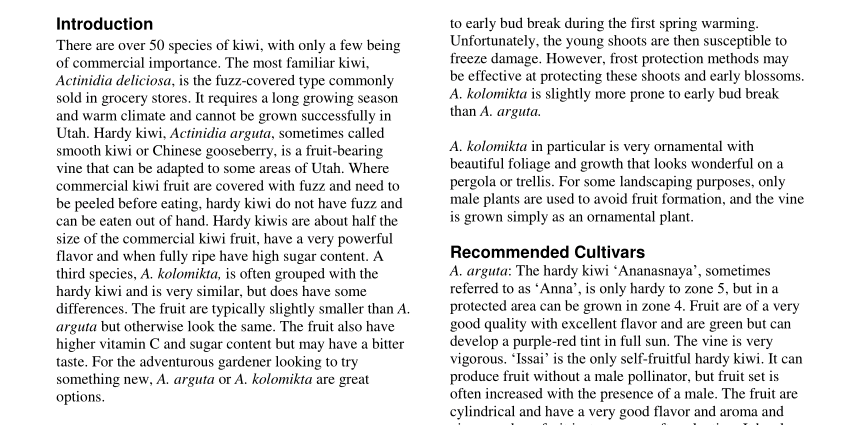Contents
Do you want to grow exotic fruits in your garden, but are afraid that tropical plants will not take root in a temperate climate? Our article will dispel all your doubts! Thanks to breeders, planting and caring for actinidia has become possible for gardeners of any climatic zone.
Features of actinidia
Actinidia is a close relative of kiwi, a perennial dioecious plant of the woody vine genus. Without support, it grows up to 1,5–2 m. Flexible, smooth stems are covered with brownish bark. Large heart-shaped leaves with a serrated edge, green, without stipules. When the shrub blooms, the tips of the leaf blades turn white, then pink and finally raspberry.
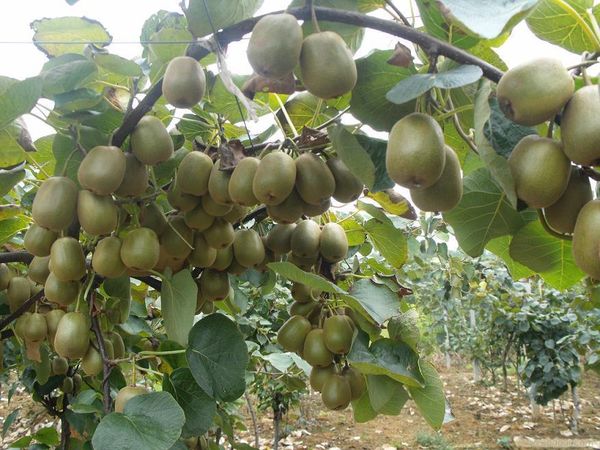
During the flowering period, which lasts from May to June, the plant is covered with cup-shaped flowers with a diameter of 1 to 3 cm. Their color depends on the variety and can be from white to purple. Most types of actinidia are odorless, but some varieties have a slight pleasant aroma. Fruit ripening begins in early autumn. Oblong edible yellow-green or light orange berries grow in size from 1 to 8 cm.
Video “Planting and caring for actinidia”
In this video, an expert will tell you how to properly plant actinidia and care for the plant.
What is the difference between female actinidia and male
It is possible to distinguish female actinidia from male only during the flowering period. When laying seeds, it is impossible to determine the outcome in advance. If you want to get beautiful flowers and tasty fruits, you need to plant both plants in the garden.
The female specimen blooms with single flowers, in which there are pistils and embryos. The male shrub is easy to recognize by the inflorescences, consisting of 3-4 flowers with many long stamens. During pollination, pollen is transferred from one plant to another.
Popular varieties for growing
In total, actinidia has more than 70 species, which include fruit and ornamental varieties. The most common are:
- Kolomikta. Frost-resistant species, withstands temperatures down to -42 ° C. Popular in the Urals and Siberia. It grows up to 5–10 m, covered by green berries 2–2,5 cm in size by the beginning of autumn. Serrated leaves are green, with a reddish pile. From September, the foliage is repainted in yellow-red and pink-purple tones. The best varieties: Lakomka, Pineapple, Doctor Shimanovsky.
- Argut. The largest of the actinidia, the stems of which reach 36 m in length. Leaf blades are serrated, smooth, dark green in color. The shrub is unpretentious and abundantly bears fruit in any conditions. Berries begin to appear in early September. Fruits up to 3 cm in size may be green or with a purple tint. The best varieties: Large-fruited, Self-fertile, Primorskaya.
- Polygam. Weakly branching liana with shoots no more than 5 m. The only species in which, in addition to fruits, leaves are also edible. Leaf plates with pointed tips are green, changing their shade only partially. Orange berries are rich in beta-carotene and taste like figs. The best varieties: Beauty, Patterned, Apricot.
Landing in open ground
Experienced gardeners recommend planting seedlings in open ground, whose age does not exceed 3 years. It is better to buy a plant whose root system is closed. Direct sunlight, high temperatures and lack of moisture can damage young actinidia.
When purchasing seedlings, it is necessary to take into account the gender of the plant. Since it is determined only by flowers, the shoots of a faded shrub are better suited. The way in which the cutting is grown is also important. Actinidia grown from seeds loses signs of belonging to the variety.
Optimal timing
Actinidia can be planted at any time of the year, except for the winter months. Gardeners do not have a common opinion about the timing, so they plant seedlings in different periods:
- in early spring (before the movement of juices);
- in the third decade of April (when the shrub fades);
- autumn (before the first frost).
Choice of location and soil composition
The ideal environment for growing actinidia should be acidic or slightly acidic. If the soil is neutral, it is well fertilized for comfortable growth. It is not recommended to plant a plant on loam, as well as places where there is a high level of groundwater. The shrub will grow comfortably on elevations, in well-drained soil.
Good predecessors and neighbors
The shrub will feel good next to plants that do not deplete the soil (blackcurrant, hazel). Improve the soil, and also maintain the optimum level of moisture legumes. You can also safely plant garden flowers nearby.
It is not recommended to grow a vine near fruit trees. They take on a lot of moisture, and hilling the underbarrel circle can harm the root system of actinidia. Also, the shoots of the bush, braiding the trunks, often “strangle” young trees.
Correct landing
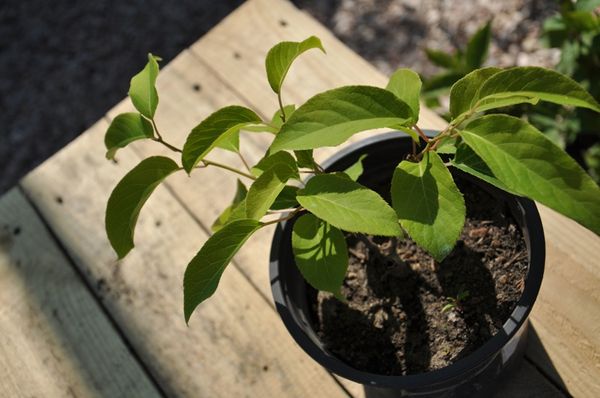

Pits for planting are prepared 2 weeks before planting. They are made at a distance of 50 cm from each other, measuring 50x50x50 cm. A drainage layer is placed on the bottom, a soil mixture is poured on top: humus, charcoal, superphosphate.
Before planting, the plant is carefully inspected and dry or damaged parts are removed. The roots are placed in a clay mash, and the planting recess is moistened with 1 bucket of water. Having lowered the plant into the hole, leave the root neck flush with the surface. The soil is compacted and mulched. Finish the procedure with abundant watering (2-3 buckets). The young stalk is covered with gauze or paper to protect it from direct sunlight.
Peculiarities of growing
Regardless of the climatic zone, decorative vines require special care and growing conditions. It is not difficult to create a comfortable environment for actinidia – it is enough to know certain agrotechnical rules.
Watering and soil care
Without proper watering, the shrub will not be able to exist normally. If the moisture level in the soil is below the required level, the plant will shed its leaves, stop growing, and will not tolerate the winter well. Excessive humidity also has a bad effect on actinidia. Gardeners recommend watering once a week. At the same time, 1-2 buckets of water are required per bush, and in dry periods the volume is doubled. After moistening, the soil is loosened, weeds are removed and covered with an additional mulch layer.
You can water actinidia on a leaf only in the morning or in the evening.
Application of fertilizers
Mineral fertilizers promote growth, branching, productivity, and also strengthen the plant before wintering. Top dressing of vines is carried out three times per season:
- in early spring: nitrogen (35 g), phosphorus and potassium (20 g each) compounds;
- during the formation of ovaries: nitrogen (15–20 g), phosphorus and potassium (10–12 g each);
- in mid-September, after harvesting: only phosphorus-potassium fertilizers (20 g each).
The preparations are distributed over the surface of the underbarrel circle and deepened into the ground by 10–12 cm. At the end of the procedure, the soil must be moistened abundantly.
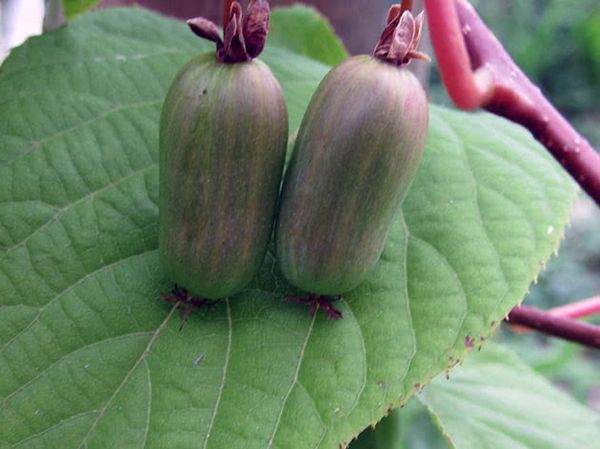

Crown formation
Gardeners recommend pruning immediately after flowering. It is necessary to remove excess shoots, as well as shorten them by a third annually. Anti-aging pruning is carried out only for plants older than 8 years. The procedure, in which the vine is cut to a stump 30-40 cm high, is carried out every 3-4 years.
For a certain type of shrub, a different pruning method is used. So, the argut must often be thinned out, shortening the stems, but the main powerful branch should not be touched. In an adult kolomikt, annually one old shoot is replaced by a young one, and the crown is formed in a fan way.
Pest and disease control
Actinidia is almost immune to infections and parasites. Proper care of the shrub is enough to keep it healthy. However, sometimes the plant can be affected by fungal diseases or leaf beetles. From rot and powdery mildew, the removal of dry or damaged shoots, as well as fruits, will save. You can destroy fungi and scare away insects with a Bordeaux mixture (1%) or a solution of soda ash (0,5%).
How to propagate actinidia
Reproduction of actinidia is a simple process. It is best to do this with cuttings, since the plant will remain belonging to the variety, gender, and it will begin to bear fruit already for 3–4 years. More hardy shrubs grow from seeds, but they will give a harvest only after 7 years.
Seeds
Planting material is washed, dried and soaked for 4 days. Soaked seeds are buried in a container with sand, regularly watering and airing them for 2 months. Then, for the same period, the container, covered with rags, is taken out into the cold. The next step is to put the seed box in a cool place, where after 20–25 days the first shoots appear. They are planted in containers with soil in half with perlite, and when the third leaf appears, they are transplanted into the ground.
Cuttings
Gardeners use two methods:
- Green cuttings. After flowering, a shoot 10-15 cm long with three buds is cut off from the bush. The shoot is planted in a hole filled with a drainage layer and a mixture of humus and sand. Cover with foil, spray twice a day and air regularly. Actinidia is transplanted into open ground in the spring.
- Woody cuttings. Pruning of branches for planting is carried out in the fall. Their length should be 20 cm. The shoots are placed vertically in the sand and kept until early March, then planted in a greenhouse. When the roots appear, the stalk is transplanted into open ground.
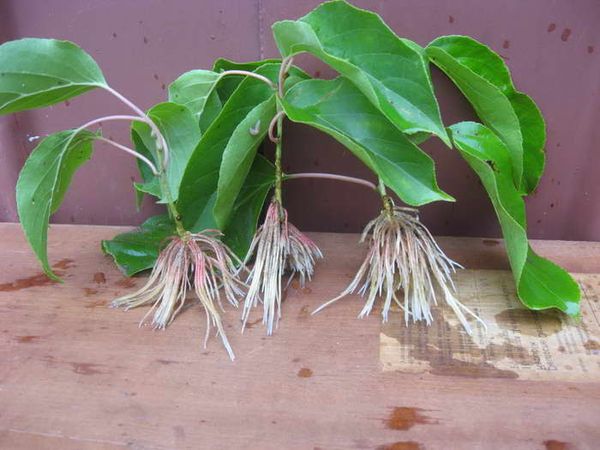

Arc layering
The method consists in dropping green shoots. Small grooves 7–10 cm deep are made under the shrub, a layer of soil mixture (sawdust, peat, humus) is covered and the lower young stem is laid, leaving the top above the surface. Having fallen asleep with earth and fixed from the wind, it is regularly watered to form an independent root system. Separate the shoot from an adult plant in the spring.
Collection, storage and use of the crop
Actinidia begins to bear fruit at the age of 3-4, and from the age of 7 it does it regularly. One shrub can produce from 12 to 60 kg of fruit. Harvest from late summer to late autumn. Ripe berries are crushed from the liana onto a spread sheet. The storage area should be cool and well ventilated. Also, the fruits can be frozen, dried or wilted.
Due to the high content of vitamin C and minerals, actinidia is very useful:
- It strengthens the immune system;
- stabilizes the work of the heart, blood composition and elasticity of blood vessels;
- beneficial effect on the organs of the respiratory system;
- fights diseases of the gastrointestinal tract;
- removes slags;
- improves skin tone and elasticity.
An ornamental plant that not only looks aesthetically pleasing, but also brings a harvest is the dream of any gardener. It is hardy and relatively unpretentious, and therefore even beginners can grow actinidia.










